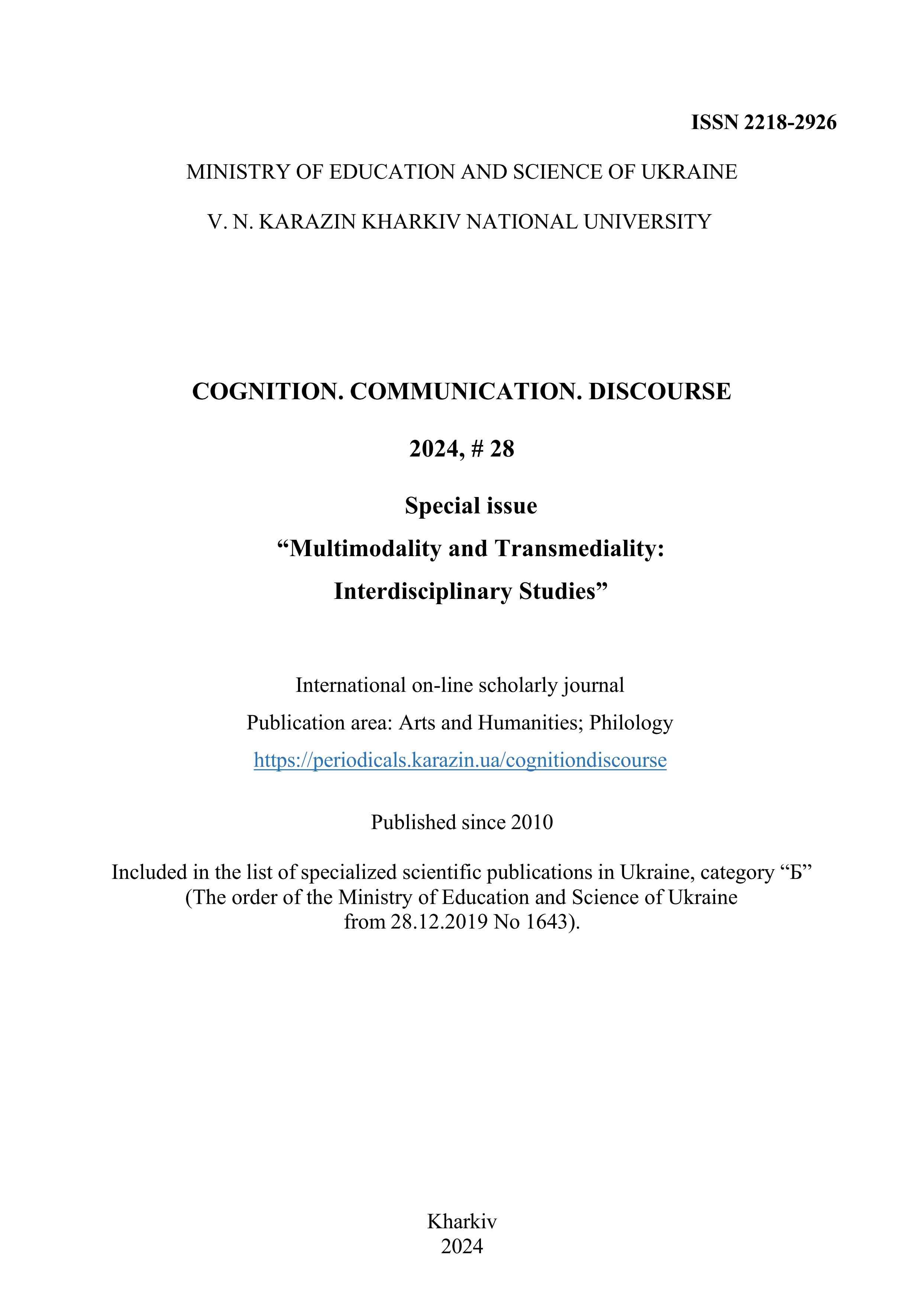Екфразис в інтермедіальній перспективі: роль фотографій в текстах про митців
Анотація
Статтю присвячено вивченню зв’язків, які виникають у процесі смислотворення в англомовній антології «Письменники про художників» (Minton, 2001) між фотопортретами художників та іншими зображеннями і вербальними текстовими компонентами. Результати дослідження демонструють, що функціонуючи як індекси, фотографії художників свідчать про реальне існування художників; як іконічні знаки, ці фотографії сприяють репрезентації унікальності митців. Завдяки цим двом ролям фотопортрети художників забезпечують статус екфразису в есе як «актуального екфразису» (у термінах Голландера). У взаємодії з біографічними нотатками фотографії художників підкреслюють унікальність цих особистостей. Як елементи мультимодальних комплексів «фото художника та біографія художника», фотопортрети художників вступають у відношення подібності та контрасту з фотографіями письменників у мультимодальних комплексах «фото письменника та біографія письменника», що сприяє створенню символічного діалогічного простору для обговорення творів образотворчого мистецтва в есе. Ті світлини, які є фотографіями не реальних людей, а намальованих портретів митців, утворюють міцні смислові зв’язки з дескриптивним екфразисом. Об’єкти, зображені на фотографіях художників, можуть підтримувати дескриптивний екфразис. Фотопортрети, які надають певну психологічну характеристику художників, підтримують інтерпретаційний екфразис. Фотографії, які завдяки символічній інтерпретації здатні символічно репрезентувати певні схеми знання, котрі мають високу релевантність для екфрастичних інтерпретацій та метаекфрастичних дискусій, потужно підтримують смисли, згенеровані в есе. Найбільший внесок у смислотворення в есе роблять ті фотографії, які мають високий потенціал бути інтерпретованими символічно.
Завантаження
Посилання
Barthes, B. (1981). Camera lucida: Reflections on photography. New York, NY: Hill and Wang.
Böger, A. (2015). Twentieth-century American literature and photography. In G. Rippl (Ed.), Handbook of intermediality (pp. 173-192). Berlin, München, Boston: De Gruyter. https://doi.org/10.1515/9783110311075-011
Bruhn, J., & Schirrmacher, B. (2022). Intermedial studies. In J. Bruhn & B. Schirrmacher (Eds), Intermedial studies. An introduction to meaning across media (pp. 3-27). London and New York, NY: Routledge. https://doi.org/10.4324/9781003174288-2
Carrier, D. (1987). Ekphrasis and interpretation: two modes of art history writing. British journal of aesthetics, 27(1), 20-31. https://doi.org/10.1093/bjaesthetics/27.1.20
Clüver, C. (2007/2016). Intermediality and interarts studies. In J. Arvidson, M. Askander, J. Bruhn, & H. Führer (Eds.), Changing borders: Contemporary positions in intermediality (pp. 19-37). Lund: Intermedia Studies Press.
Eco, U. (1984). Semiotics and the philosophy of language. Bloomington, IN: Indiana University Press.
Elleström, L. (2021). The modalities of media II: An expanded model for understanding intermedial relations. In L. Elleström (Ed.), Beyond media borders, Volume 1. Intermedial relations among multimodal media (pp. 3-91). London: Palgrave Macmillan. https://doi.org/10.1007/978-3-030-49679-1_1
Elsner, J. (2002). Introduction: The genres of ekphrasis. Ramus, 31(1-2), 1-18. https://doi.org/10.1017/S0048671X00001338
Fjellestad, D. (2015). Nesting – braiding – weaving: Photographic interventions in three contemporary American novels. In G. Rippl (Ed.), Handbook of intermediality: Literature – image – sound – music (pp. 193-218). Berlin, München, Boston, MA: De Gruyter.
Freeland, C. (2007). Portraits in painting and photography. Philosophical Studies, 135, 95-109. https://doi.org/10.1007/s11098-007-9099-7
Gavins, J., & Steen, G. (Eds.). (2003). Cognitive poetics in practice. London and New York, NY: Routledge.
Heffernan, J. A.W. (1991). Ekphrasis and representation. New Literary History, 22(2), 297-316.
Horstkotte, S. (2017) Ekphrasis as genre, ekphrasis as metaphenomenology In R. Bodola & G. Isekenmeier (Eds.), Literary visualities: Visual descriptions, readerly visualisations, textual visibilities (pp. 127-164). Berlin, Boston, MA: De Gruyter. https://doi.org/10.1515/9783110378030-005
Koopman, N. (2014). Ancient Greek ekphrasis: Between description and narration [Doctoral dissertation, University of Amsterdam]. https://dare.uva.nl/search?identifier=511a0974-315e-4072-b9fe-c9314c99ce68
Krieger, M. (2019). Ekphrasis: The illusion of the natural sign. Baltimore, MD: John Hopkins University Press. https://doi.org/10.1353/book.68495
Lefebvre, M. (2002). Photography and semiotics: Use and purpose. Critical inquiry, 48(4), 742-773. https://doi.org/10.1086/719852
Mitchell, W. J. T. (1994). Ekphrasis and the other. Picture theory: Essays on verbal and visual representation. Chicago, IL: The University of Chicago Press. Retrieved from https://complit.utoronto.ca/wp-content/uploads/COL1000-Week11-Nov25_WJT_Mitchell.pdf
Rajewsky, I. O. (2005). Intermediality, intertextuality, and remediation: A literary perspective on itermediality. Intermédialités, 6, 43-64. https://doi.org/10.7202/1005505ar
Semino, E. (1995). Schema theory and the analysis of text worlds in poetry. Language and Literature, 4(2), 79-108. https://doi.org/10.1177/096394709500400201
Sontag, S. (1977/2019). On photography. London: Penguin Books.
Stockwell, P. (2002). Cognitive poetics. An introduction. London and New York, NY: Routledge.
Straub, J. (2015). Nineteenth-century literature and photography. In G. Rippl (Ed.), Handbook of intermediality: Literature – image – sound – music (pp. 156-172). Berlin, München, Boston, MA: De Gruyter.
Vorobyova, O., & Lunyova, T. (2020). Verbal and non-verbal facets of metaekphrastic writing: A cognitive study of John Berger’s essays on visual art. Lege artis. Language yesterday, today, tomorrow. The journal of University of SS Cyril and Methodius in Trnava, V(2), 335‒381.
Авторське право (c) 2024 Тетяна Луньова

Цю роботу ліцензовано за Міжнародня ліцензія Creative Commons Attribution-NonCommercial-NoDerivatives 4.0.
Автори, які публікуються у цьому журналі, погоджуються з наступними умовами:
Автори залишають за собою право на авторство своєї роботи та передають журналу право першої публікації цієї роботи на умовах ліцензії Creative Commons Attribution License (CC BY), яка дозволяє іншим особам вільно розповсюджувати опубліковану роботу з обов'язковим посиланням на авторів оригінальної роботи та першу публікацію роботи у цьому журналі.
Автори мають право укладати самостійні додаткові угоди щодо неексклюзивного розповсюдження роботи у тому вигляді, в якому вона була опублікована цим журналом (наприклад, розміщувати роботу в електронному сховищі установи або публікувати у складі монографії), за умови збереження посилання на першу публікацію роботи у цьому журналі.
Політика журналу дозволяє і заохочує розміщення авторами в мережі Інтернет (наприклад, у сховищах установ або на особистих веб-сайтах) рукопису роботи, як до подання цього рукопису до редакції, так і під час його редакційного опрацювання, оскільки це сприяє виникненню продуктивної наукової дискусії та позитивно позначається на оперативності та динаміці цитування опублікованої роботи (див. The Effect of Open Access).




